Author: This article is part of an expert series written by Fadi Daou, the CEO of MultiLane – a high speed test and measurement (T&M) company based in Lebanon. Daou discusses the move from 400G to 800G Ethernet at the leading edge of data communication, the challenges and solutions at these high speeds and throughputs, and Lebanon’s role in the industry.
[Disclaimer: The below article is the author's personal opinion]
The COVID-19 pandemic has accelerated the already dramatic shift to online spaces in every aspect of our lives. From Netflix streaming, to Zoom calls, to sharing documents on Office365 or Google Docs, we are now using more bandwidth than ever. The speed at which data centers can communicate internally correlates directly to how fast they can provide their services. Increasing speeds at the user end – with 5G or faster home WiFi for example – requires exponentially faster speeds at the server end. To accommodate for this ever-increasing demand, hyperscalers – like Google, Amazon, and Microsoft – are constantly working on faster, more efficient technologies.
Data centers operate on the most fundamental layer of the internet, the physical layer, which deals directly with streams of bits – 1s and 0s – transferred via electrical, or, more frequently, optical signals. On this layer, different technologies that enable the rapid transfer of data come together under the Ethernet Specification.
The year 2021 has seen widespread adoption of 400 Gigabit Ethernet (400G), currently the fastest commercially available means of transferring data. Companies like Microsoft are migrating their data center infrastructure from 100G to 400G in anticipation of increasing bandwidth usage over the next five years, but other hyperscalers are pushing to go even faster.
At the leading-edge of data communications, we must always operate in anticipation of future technologies that may be two, three, and even four years in advance of what is available now. If 400G is being adopted now, then it is a certainty that the next stage, 800G Ethernet, is no longer a technology of the future but of the present, with prototypes and standards already in development.
The rapid approach of 800G Ethernet is all the more certain given that 400G relies on revolutionary new technology, which has laid the foundation for 800G and beyond. As a full breakdown of these technologies is outside the purview of this article, I will focus on two factors that are central to this revolutionary shift in data communications: the move from NRZ to PAM4 signaling and the need for heat dissipation.
A Tale of Two Signals
Gigabit Ethernet works by sending one or more signals through a fiber optic cable at a certain speed. Previous generations would send information one bit at a time through a Non-Return to Zero (NRZ) signal. At 100G and below, NRZ is ideal as it can allow for error-free transfer of data. However, NRZ signals cannot provide reliable throughput at 400G, which has caused a shift to, and heavy reliance on, a different type of signaling method: PAM4. PAM4 splits a single signal into four levels, each of which can transfer two bits per cycle. This allows for faster transfer of information and less interference at 400G and above.

But PAM4 isn’t without its own challenges.
Such a busy signal means that noise, and therefore errors – instances where a 1 is interpreted as a 0 and vice versa – are inevitable. Companies looking to implement 400G and above must be able to have a keen awareness of what these errors are and how to account for them. Testing equipment, like Bit Error Rate Testers (BERTs), advanced oscilloscopes, and loopback modules are crucial as they ensure data center functionality. Modern testing instruments can even apply methods of mitigating errors directly to see how they might be implemented in the field. For PAM4 signals, the most common way to ensure no information is lost is Forward Error Correction (FEC), which appends the data with additional bits and codewords that allow for a certain amount of data recovery even with errors in the signal.

Keeping Things Cool

Processing so much information at a time causes significant heat buildup in the pluggable modules, which, if improperly dealt with, can damage the equipment. Heat dissipation through these modules is, therefore, essential to the functioning of the entire system. Here, test and measurement equipment once again plays a vital role. The interconnects used to stress-test ports or systems, called loopbacks, run ports at their highest power threshold to see how they cope, and what additional cooling methods are required to allow for more effective heat dissipation.
(Data Center Rack Being Tested)
Connecting to Lebanon
My expertise is in test and measurement, but my passion has always been to see my country thrive. 30 years ago, I promised my father amongst the olive and pine trees of my ancestral village that I would return to Lebanon when I was ready to create high tech jobs for my fellow Lebanese. Lebanon has never lacked for talent, only opportunity, and my goal is to bring these opportunities home.
Shifting Lebanon’s economic focus from internal to international would go a long way to solving our current crisis. All that is needed is a better ecosystem that enables global competition and moves our economy to double digit growth. Updates to our labor laws would prove very helpful, as it would provide proper incentivization for international companies. However even without them, Lebanon is still rising to the occasion remarkably, all things considered.
Initiatives like my own Houmal Technology Park (HTP) already stand as a testament to Lebanon’s capacity to compete on an international scale. Even in the midst of economic turmoil, bright young Lebanese are working to turn their country into a hub for the ICT industry. One of the companies headquartered at HTP, MultiLane, is able to keep pace even with the lightning fast high-speed I/O industry, with an excess of 4000 interconnect modules shipped every week. Test and measurement instruments manufactured right here are being used in major data centers around the world.
Looking to the future, if our work continues as it has, I anticipate and continue to strive to create even greater growth and more local opportunities as the world starts to take notice of Lebanon’s untapped potential.
